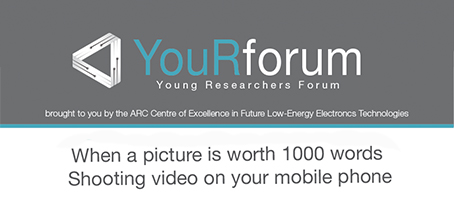-
19 Oct 2017
2:00 pm - 4:30 pm
What kind of visual material are the media looking for and how can you use this knowledge to communicate your research to the public?
How do you actually shoot video?
This free training workshop will give you the skills to share your science by video, including a ‘pro’ video app.
If a picture is worth 1000 words, then at 25 pictures per second, video is a priceless tool for communicating in the booming online world. The explosion in digital media brings an endless demand for science news in a visual format. No longer just the domain of television, video is used by online media to grab attention, explain complex ideas and share stories through social media. Journal publishers increasingly ask for video abstracts to accompany research papers.
Led by the Australian Science Media Centre’s Lyndal Byford, the workshop will cover:
- Why do we need to bother with video?
- How do I produce video the media will use?
- How to distil an idea and find a visual way to represent it
- Knowing your audience – different visual strokes for different folks
- How to use your smart phone to shoot video
To ensure you get the best use of the workshop, you will be provided with either an iTunes or a Google Pay gift card to download of the FiLMiC Pro smartphone app, worth $22.99 on iOS (iphone) and $12.99 on Google Play (Android).
This session is open to PhDs, HDR students and early career researchers, from any institution. So if you know of anyone else who would benefit, please send them this link.
Registration is essential, please RSVP your attendance by October 15.
This workshop counts towards Monash professional development hours.
Lyndal Byford is Acting CEO at the Australian Science Media Centre, where she transforms complex science papers into tasty tabloid morsels for mainstream news journalists. Lyndal’s science communication experience includes science museums, the pharmaceutical industry, media relations in Australia and the UK, regular public forums, Crikey, Cosmos, the ABC and News Corp Australia. She was a member of Inspiring Australia’s ‘Science and the Media Expert Working Group’ for the Federal Department of Innovation, Industry, Science and Research.
Co-presented with FLEET’s education liaison, the Tall Poppy Campaign, Australian Institute of Policy and Science (AIPS).

Visitors & parking at Monash Clayton Visitors are very welcome to attend this training workshop. A map of the Clayton campus can be found online. There are designated visitors car parks in the “N1” building (marked in blue, towards top left of the map) just west of the New Horizons Building. Visitor spaces are available on the ground floor (limited spaces) and top floor (level six, lots of spaces). Tickets are $10/day or $2/hour, available from machines. More parking information.
Venue: G30 New Horizons Centre, Monash University
Venue Website: https://www.monash.edu/engineering/our-research/facilities/new-horizons
Address:
